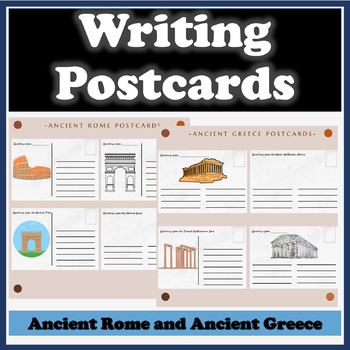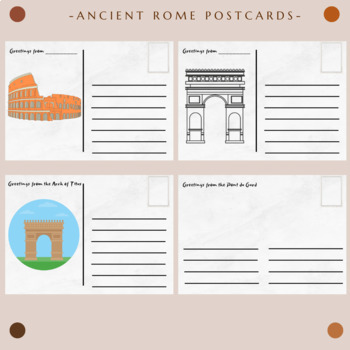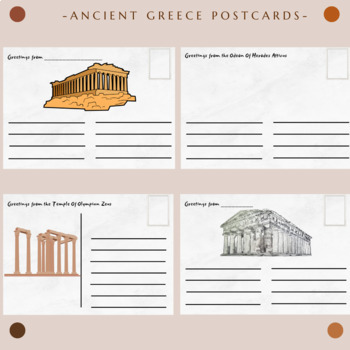Writing Postcards Simulation - Ancient Rome and Ancient Greece
- Zip
What educators are saying
Products in this Bundle (2)
Description
This Bundle includes Postcards with the images of:
- 7 famous Ancient Greek Buildings: Parthenon, Odeon of Herodes Atticus, Erechtheion, Temple of Apollo, Temple of Zeus, Temple of Athena Nike and Temple of Concordia.
- 8 famous Ancient Rome Buildings: Colosseum, Pantheon, Pont du Gard, Aqueduct of Segovia, Arch of Titus, The Roman Forum, Mausoleum of Augustus and Porta Nigra.
To make preparation for teachers as easy as possible, I added a Summary with main info about each of these historical buildings and made a PPT presentation (check out my video review) with high quality photos, including photos of 3D reconstructions of each building.
I designed 4 Postcard versions:
• Without the name of the building and with a colored/reconstructed photo or drawing
• With a name and colored/reconstructed photo or drawing
• With a name and without any photos or drawings
• Without the name of the building but with graphic icons
You can choose whichever version(s) that fit best with your class. The other version remain yours in case you ever need to use them. You can be very creative when using postcards. I can suggest some options:
- Review activity about Ancient Greek/Ancient Rome Art History and Architecture
- Coloring and drawing activities
- Simulations – they can be travelers living in that historical time visiting Ancient Greece/Rome or simply travelers visiting nowadays Athena, Rome and other cities where the building still standing
- Writing exercises – student can write simple travel stories, famous latin phrases and sayings, observations about building, fictional stories connected with a certain building (for example soldiers from certain wars writing postcards to their families), poems..
- Peer to peer activities – students write postcards to each other, to imaginary characters or to certain historical figures
Postcards can be displayed later in your classroom. It would be great to hear how you have used this resource in your class, I am sure you will all have numerous ideas.
_ _ _ _ _ _ _ _ _ _ _ _ _ _ _ _ _ _ _ _ _ _ _ _ _ _ _
Customer Tips:
How to get TPT credit to use on future purchases:
Please go to your My Purchases page (you may need to login). Beside each purchase you'll see a Provide Feedback button. Simply click it and you will be taken to a page where you can give a quick rating and leave a short comment for the product. Each time you give feedback, TPT gives you feedback credits that you use to lower the cost of your future purchases.
I value your feedback greatly as it helps me determine which products are most valuable for your classroom so I can create more for you.





